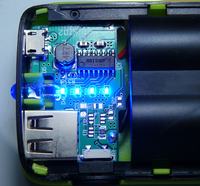All in all, I don't even know if it's a fault or "these types have it."
It looks like this:

The point is that this power bank, with loads less than 200mA, every 9s turns off the output voltage for half a second and turns it on again.
With a load of e.g. 500mA, it works perfectly well, i.e. it supplies current without interruptions.
What's more strange, somewhere within 200mA the system flashes but if the cube warms up slightly after some time it starts to work continuously.
Apparently, this does not impair this device as a charger, but I also care about using it as an adapter for Arduino or Nucleo plates, where these breaks completely exclude it from this application.
And I just have these questions.
Is it supposed to be this way in this particular solution (although all my other power banks, but on other bones, they easily switch on permanently at currents of several dozen mA)? Maybe someone has already fought it?
Does any of my colleagues have any bearing on any part of documentation, application etc. of the HT4936S system? Or maybe he knows some exact counterpart, better documented.
I haven't found anything valuable about the HT4936S chip, even from the manufacturer who doesn't admit it. I still have a weak hope that somehow this current threshold can be changed (e.g. it is unfilled R3, some legs by weight etc.) but without documentation it is impossible.
It looks like this:

The point is that this power bank, with loads less than 200mA, every 9s turns off the output voltage for half a second and turns it on again.
With a load of e.g. 500mA, it works perfectly well, i.e. it supplies current without interruptions.
What's more strange, somewhere within 200mA the system flashes but if the cube warms up slightly after some time it starts to work continuously.
Apparently, this does not impair this device as a charger, but I also care about using it as an adapter for Arduino or Nucleo plates, where these breaks completely exclude it from this application.
And I just have these questions.
Is it supposed to be this way in this particular solution (although all my other power banks, but on other bones, they easily switch on permanently at currents of several dozen mA)? Maybe someone has already fought it?
Does any of my colleagues have any bearing on any part of documentation, application etc. of the HT4936S system? Or maybe he knows some exact counterpart, better documented.
I haven't found anything valuable about the HT4936S chip, even from the manufacturer who doesn't admit it. I still have a weak hope that somehow this current threshold can be changed (e.g. it is unfilled R3, some legs by weight etc.) but without documentation it is impossible.


